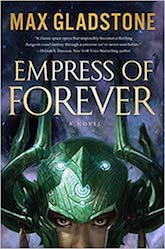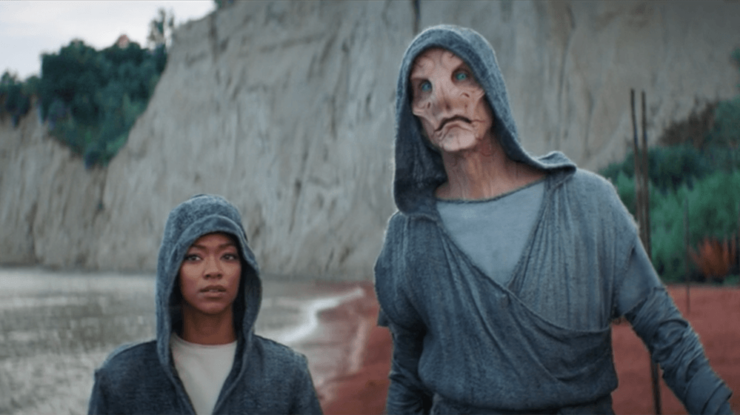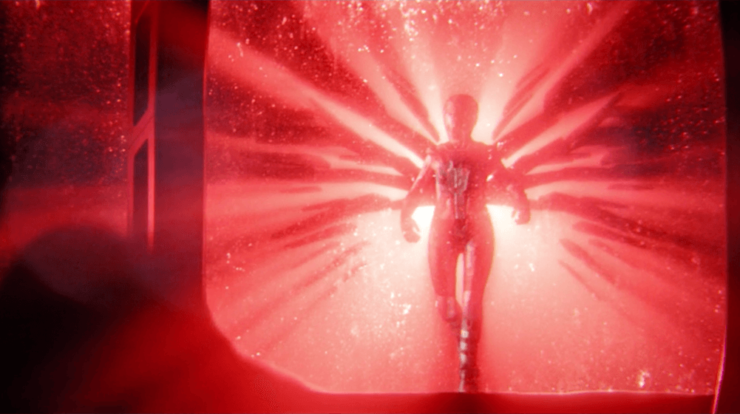One of the most problematic aspects of the general Star Trek oeuvre over the past 53 years has been General Order #1, a.k.a. the Prime Directive. First mentioned in “Return of the Archons” on the original series, it has been interpreted, reinterpreted, ignored, misrepresented, and generally been a bane to writers and viewers alike for five decades.
And it gets quite the workout in “The Sound of Thunder,” as Saru pretty much bullies the crew into stepping on several butterflies…
This episode picks up from both the revelation about Saru’s people in “An Obol for Charon” (as well as the huge amount of data from the sphere Discovery collected in that episode) as well as the Short Treks episode “The Brightest Star.”
Saru returns to Kaminar for the first time since he requested asylum of Lieutenant Georgiou eighteen years previous, and now he knows that the Kelpiens’ entire culture is based on a lie. He knows the Ba’ul have culled his people, not to keep them from madness, but to keep them from exploring their full potential. He brings his fear-ganglia-free head with him to the surface, and a reunion with his sister Siranna (played again by the delightful Hannah Spear), who has replaced their father Aradar as the village priest, said father having been culled. At first Saru and Burnham try to avoid screwing around with the planet too much, but before long the Ba’ul themselves intervene, as they’re not happy to see Saru.
I was not kind to “The Brightest Star,” and while I stand by what I said in the review, I will give “The Sound of Thunder” (and “An Obol for Charon” before it) credit for taking what was established in the short episode and making it more interesting. I still prefer the idea of sentient prey animals that are actually hunted, but since we’re now stuck with this version of the Kelpiens, I give the writing staff in general and Bo Yeon Kim and Erika Lippoldt credit for making it work. (Kim and Lippoldt also wrote “The Brightest Star.”)
Buy the Book


Empress of Forever
But what especially works is the revelation that the Kelpiens used to be the predators. Yes, they’re fearful and timid in their caterpillar form, but in their butterfly form after going through the vahar’ai they are fierce. And also very physically powerful. We get a notion of this right away as Saru is far more confident and snotty now, talking back to Pike, forgetting to get up from the command chair when the captain comes onto the bridge, and just generally being an arrogant ass. Later, he grabs robot drones and crushes them with his bare hands.
And then we get the truth, learned by Burnham, Tilly, and Airiam from the sphere’s database, and also by Saru and Siranna after they are kidnapped by the Ba’ul. The Ba’ul were almost exterminated by the Kelpiens, but then they fought back, eventually using technology and religious propaganda to reverse those positions. Now the Ba’ul kill the Kelpiens before they can go from caterpillar to butterfly, and while it’s an understandable response to nearly being exterminated, they go too far in the other direction. They have enslaved the Kelpiens.
Here’s where the Prime Directive issues get murky. I mean, they’re already murky to a degree. It’s easy to say that Starfleet should interfere in a bad situation, but what defines a bad situation is a slippery slope. The argument for General Order #1 is very nicely spelled out during the conversation on the subject in “Pen Pals” on The Next Generation—but ultimately, they can’t turn their backs on a cry for help.
One of the biggest issues I’ve had with rigid “we must not interfere at all!” Prime Directive stories—the worst offenders being TNG’s “Who Watches the Watchers?” and “Homeward” and Enterprise’s “Dear Doctor”—is that they tend to turn the main characters into uncaring bastards when they’re supposed to be heroes. Heroes should never allow people to die when they can be saved. And many of them—”Dear Doctor” being a particular offender—tend to view evolution as this rigid straight line of inevitability that the Prime Directive keeps Starfleet from interfering with. But that’s not how evolution works. It’s not a straight line, it’s a jagged, curved, random, ridiculous line being navigated by a drunk driver. Evolution is constantly shifting, and it’s affected by dozens of external factors.
In the end, of course, the Discovery crew does help the Kelpiens, in part because, even if you buy the “natural order of things” argument, the Ba’ul already squeezed that toothpaste out of the tube when they set up the cullings that kept the Kelpiens from reaching their mature state. And so, using the same frequency that the sphere used, which triggered Saru’s vahar’ai two episodes ago, Saru is able to use the Ba’ul monitors that are on every village to trigger the vahar’ai in all his people. He does so after a lengthy conversation from the Ba’ul ship to Discovery, which gives us the episode’s biggest issue, as it really makes no sense that the Ba’ul wouldn’t respond to Saru crushing the drones. Instead, they get to babble back and forth with Pike and Burnham and Tilly and enact their plan to save the Kelpiens conveniently without any interference from the Ba’ul. I mean, seriously, were they all on a coffee break, or what?
In true Star Trek tradition—at least on the original series—our heroes completely upend the social structure of a world in order to save it. We’ve seen it lots of times, starting on the very episode that introduced General Order #1, “The Return of the Archons,” not to mention “The Apple,” “A Taste of Armageddon,” “A Private Little War,” “The Gamesters of Triskelion,” etc.
The only thing that stops the Ba’ul from committing genocide to avoid having to deal with the butterfly Kelpiens again is the Red Angel, which shows up as a deus ex machina to shut down the monitors and keep them from scorching the earth. (Saru has now also seen the Red Angel, joining Burnham and Spock as having sighted the thing.) Discovery only went to Kaminar in the first place because one of the Red Angel’s signals appeared there. There are a couple of discussions between Pike and Tyler—still on board as the Section 31 liaison—on the subject of whether or not the signals and the Red Angel are benevolent or a threat. Pike points out that everywhere they’ve chased a signal has involved saving lives, whether Discovery’s rescue of the Hiawatha in “Brother,” the Red Angel’s apparent rescue of the 21st-century Earth citizens from certain death in “New Eden,” and now saving the Kelpiens from being the Ba’ul’s victims. Tyler doesn’t believe they can assume benevolence, and Burnham is the one who points out that the real issue is that they don’t know who’s right, and they need more information.
I think the conversation was a good one—and Anson Mount, as usual, sells Pike’s very Starfleet-ish optimism—but I really hope we don’t get endless reruns of that conversation throughout the rest of the season until we find out what the Red Angel actually is. We already had it between Pike and Leland last week, and I fear it growing real tiresome real fast.
The Ba’ul are magnificently alien creatures, Farscape-level quality aliens (which is the highest compliment I can give an alien being design on a screen SF story, as no show has matched what the Henson Creature Shop was able to accomplish on that Sci-Fi Channel show two decades ago). I would have preferred a bit less filtering of their voices, as half the time I needed the closed captioning to understand what they were saying, but I’m willing to forgive that for the fantastic visuals. (For the record, as the episode was airing, my wife and I both theorized that the Ba’ul would actually be the evolved Kelpiens, and we’d find out that nobody died. We were both quite happy to be wrong, as this made for a better story.)
Meanwhile, Culber is not exactly the same as he was when last we saw him. He seems to be a physically idealized version of Culber—he no longer has a scar that he kept because the incident where he got the scar inspired him to go to medical school—and he doesn’t seem entirely comfortable. Culber, Saru, and Tyler are all deeply affected by what they’ve gone through. I like that Agent Tyler is already different—a weird combination of Torch-Bearer Voq and Lieutenant Tyler—and we should be seeing the same with Saru and Culber. Hopefully Saru won’t stay an asshole, though I’m curious to see what use he’s going to put those quills he can now shoot from his head…
The episode ends with Burnham deciding to go back to Vulcan in the hopes of finding something that will lead them to Spock (as both Discovery and Section 31 have dead-ended in their search for him). Based on the previews, we should finally see Spock next week, seven episodes into a fourteen-episode season that has been advertised almost exclusively on Spock being in it. Let’s hope they don’t pull a “Unification I” and not have him show up until the very end.
Keith R.A. DeCandido‘s latest novel is A Furnace Sealed, the debut of his new Bronx-based urban fantasy series “The Adventures of Bram Gold.” Ordering information and an excerpt can be found here.











